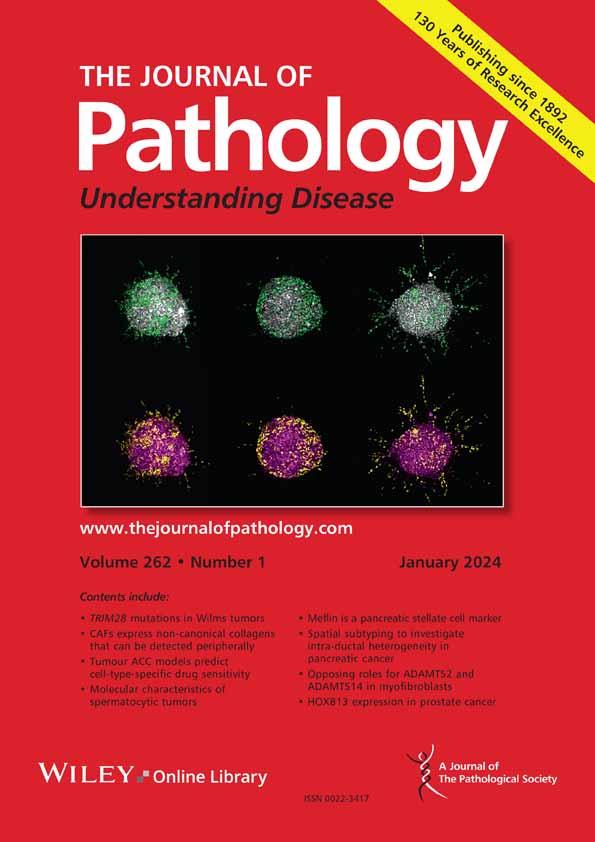Yoshitsugu Mitani, Haneen Al-Maghrabi, Tatiana V Karpinets, Raissa T Relator, Lauren Hilder, Irene Y Chen, Ryan P Goepfert, Diana Bell, Jianhua Zhang, Renata Ferrarotto, Adel K El-Naggar
求助PDF
{"title":"Comparative transcriptomics of salivary basal cell adenoma and adenocarcinoma sustain linear neoplastic evolution and intertumor heterogeneity: classification and biological implications","authors":"Yoshitsugu Mitani, Haneen Al-Maghrabi, Tatiana V Karpinets, Raissa T Relator, Lauren Hilder, Irene Y Chen, Ryan P Goepfert, Diana Bell, Jianhua Zhang, Renata Ferrarotto, Adel K El-Naggar","doi":"10.1002/path.6424","DOIUrl":null,"url":null,"abstract":"<p>It remains uncertain whether basal cell adenoma (BCA) and basal cell adenocarcinoma (BCAC) of the salivary gland represent two distinct neoplasms or temporal stages of a single entity. The issue is central to reconciling their shared phenotypic resemblance and protracted behavior with current pathologic classification. We conducted a transcriptomic analysis on a cohort of both pathologic forms and correlated the findings with the clinicopathologic features using RNA extracted from fresh frozen samples of 25 salivary basal tumors (five BCAs and 20 BCACs) and eight instances of metastatic basal cell carcinomas (BCCs) to parotid glands. Unsupervised analysis revealed shared and intertumoral transcriptome differences within and between BCA and BCAC and distinct segregation from metastatic dermal BCC. Transcriptomic profiling delineated two intermixed subgroups of salivary basal cell neoplasms (SBNs); SBN-I group enriched with adverse pathologic features and SBN-II that lacked any of these features except for a single case. The category with the most instances of adverse pathologic features (SBN-I) manifested upregulations of transcriptional factors linked to cell proliferation pathways (<i>HOXB13</i>, <i>SOX21</i>, <i>MYB</i>, and <i>EN1</i> genes), while those lacking adverse pathologic features (SBN-II) demonstrated a high expression of the <i>TFAP2B</i> transcription- and differentiation-related pathways. Our transcriptomic findings support common neoplastic evolution and intertumoral heterogeneity of both pathologic forms of basal cell neoplasms and identify molecular pathways of potential biological and clinical significance. We therefore propose a nondeterministic designation of ‘basal cell salivary neoplasms, noninvasive (adenoma)/invasive (adenocarcinoma)’ as a platform that integrates conventional phenotypic classification and transcriptomic characteristics pending a classification consensus. © 2025 The Pathological Society of Great Britain and Ireland.</p>","PeriodicalId":232,"journal":{"name":"The Journal of Pathology","volume":"266 3","pages":"258-267"},"PeriodicalIF":5.2000,"publicationDate":"2025-04-24","publicationTypes":"Journal Article","fieldsOfStudy":null,"isOpenAccess":false,"openAccessPdf":"","citationCount":"0","resultStr":null,"platform":"Semanticscholar","paperid":null,"PeriodicalName":"The Journal of Pathology","FirstCategoryId":"3","ListUrlMain":"https://pathsocjournals.onlinelibrary.wiley.com/doi/10.1002/path.6424","RegionNum":2,"RegionCategory":"医学","ArticlePicture":[],"TitleCN":null,"AbstractTextCN":null,"PMCID":null,"EPubDate":"","PubModel":"","JCR":"Q1","JCRName":"ONCOLOGY","Score":null,"Total":0}
引用次数: 0
引用
批量引用
Abstract
It remains uncertain whether basal cell adenoma (BCA) and basal cell adenocarcinoma (BCAC) of the salivary gland represent two distinct neoplasms or temporal stages of a single entity. The issue is central to reconciling their shared phenotypic resemblance and protracted behavior with current pathologic classification. We conducted a transcriptomic analysis on a cohort of both pathologic forms and correlated the findings with the clinicopathologic features using RNA extracted from fresh frozen samples of 25 salivary basal tumors (five BCAs and 20 BCACs) and eight instances of metastatic basal cell carcinomas (BCCs) to parotid glands. Unsupervised analysis revealed shared and intertumoral transcriptome differences within and between BCA and BCAC and distinct segregation from metastatic dermal BCC. Transcriptomic profiling delineated two intermixed subgroups of salivary basal cell neoplasms (SBNs); SBN-I group enriched with adverse pathologic features and SBN-II that lacked any of these features except for a single case. The category with the most instances of adverse pathologic features (SBN-I) manifested upregulations of transcriptional factors linked to cell proliferation pathways (HOXB13 , SOX21 , MYB , and EN1 genes), while those lacking adverse pathologic features (SBN-II) demonstrated a high expression of the TFAP2B transcription- and differentiation-related pathways. Our transcriptomic findings support common neoplastic evolution and intertumoral heterogeneity of both pathologic forms of basal cell neoplasms and identify molecular pathways of potential biological and clinical significance. We therefore propose a nondeterministic designation of ‘basal cell salivary neoplasms, noninvasive (adenoma)/invasive (adenocarcinoma)’ as a platform that integrates conventional phenotypic classification and transcriptomic characteristics pending a classification consensus. © 2025 The Pathological Society of Great Britain and Ireland.
唾液基底细胞腺瘤和腺癌的比较转录组学维持线性肿瘤进化和肿瘤间异质性:分类和生物学意义。
涎腺基底细胞腺瘤(BCA)和基底细胞腺癌(BCAC)是否代表两种不同的肿瘤或单一实体的时间分期仍不确定。这个问题的核心是调和他们共同的表型相似性和持久的行为与当前的病理分类。我们对这两种病理形式的队列进行了转录组学分析,并使用从25例唾液基底肿瘤(5例bca和20例bca)和8例腮腺转移性基底细胞癌(bcc)的新鲜冷冻样本中提取的RNA将结果与临床病理特征联系起来。无监督分析揭示了BCA和BCAC内部和之间的共享和肿瘤间转录组差异,以及与转移性真皮BCC的明显分离。转录组学分析描述了唾液基底细胞肿瘤(sbn)的两个混合亚群;SBN-I组有丰富的不良病理特征,而SBN-II组除了一个病例外没有这些特征。不良病理特征最多的类别(SBN-I)表现出与细胞增殖途径相关的转录因子(HOXB13、SOX21、MYB和EN1基因)的上调,而缺乏不良病理特征的类别(SBN-II)表现出TFAP2B转录和分化相关途径的高表达。我们的转录组学研究结果支持基底细胞肿瘤两种病理形式的共同肿瘤进化和肿瘤间异质性,并确定潜在的生物学和临床意义的分子途径。因此,我们提出了一个不确定的“基底细胞唾液肿瘤,非侵入性(腺瘤)/侵入性(腺癌)”的命名,作为一个整合传统表型分类和转录组特征的平台,等待分类共识。©2025英国和爱尔兰病理学会。
本文章由计算机程序翻译,如有差异,请以英文原文为准。




 求助内容:
求助内容: 应助结果提醒方式:
应助结果提醒方式:


